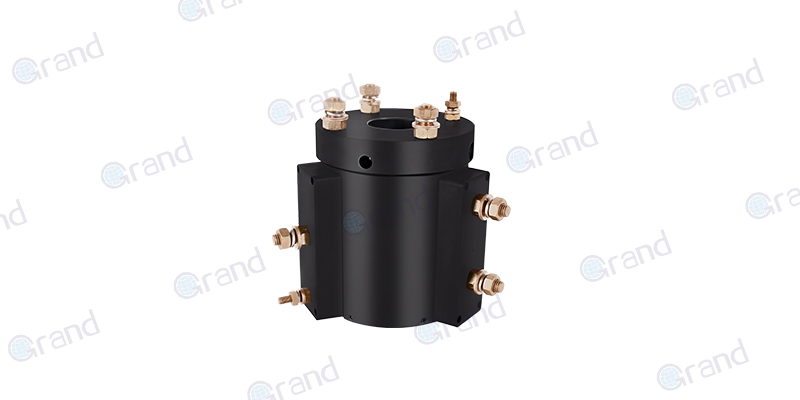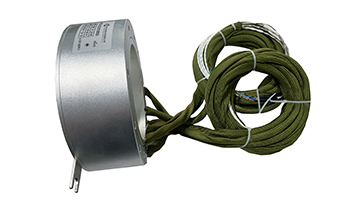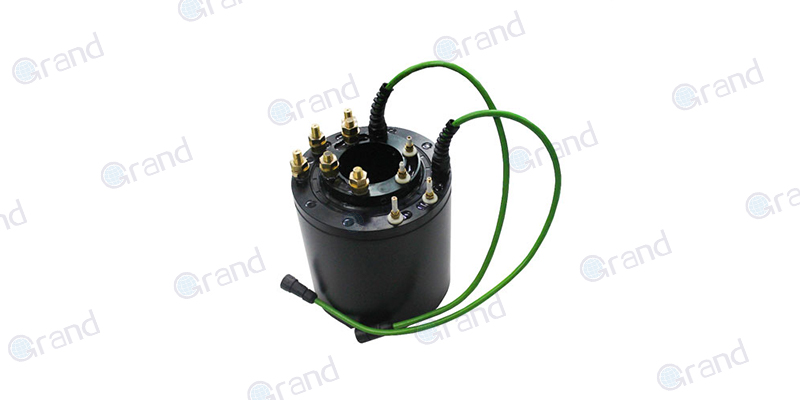In the vast ecosystem of electrical and mechanical components, slip rings—or rotary electrical connectors—have a crucial role. An integral part of many electromechanical systems that require unrestricted, continuous rotation while transferring power and data, the ability of slip rings to provide power is a vital component of their functionality. This power is what we refer to as “Slip Ring Power.”
At the most basic level, slip ring power is the electrical power that a slip ring is designed to transmit from a stationary to a rotating component of an assembly. As the heart of a slip ring system, the power underlies one of its most essential functions, namely the provision of power for rotating parts without impeding their movement.
Understanding slip ring power also involves appreciating its importance and scalability. Slip rings offer a simple yet ingenious solution to the complex paradox of providing power to moving components. In its most common use, a slip ring can be observed in, for instance, a conventional wind turbine, where it enables the rotor to rotate freely while transmitting generated electrical power to the stationary grid system. In such applications, it’s not just about ensuring rotation. It’s about guaranteeing that as much generated power as possible is efficiently conveyed from the rotating parts to the stationary parts, and then onto the grid, with minimal energy loss.
The role of slip ring power extends to applications as large as a spacecraft antenna or as small as a miniature camera, outlining its significance across a spectrum of applications. With the advent of technology, requirements for more efficient power transmission, data communication, and systems control have escalated, placing higher expectations on slip ring power.
Thus, the exploration of slip ring power is not just a technical discussion but crucial for improving overall system efficiency, reliability, and longevity.
Understanding Slip Ring Power
As we delve into the world of electromechanical systems, it becomes crucial to comprehend the underlying mechanism of how slip ring power is created and transferred. In essence, the generation of slip ring power pivots around the interaction of static and rotating components.
To visualize it better, imagine the slip ring as a rotating bridge that connects the stationary section (the stator) to the rotating section (the rotor) of a device. The slip ring assembly comprises conductive rings attached to the rotor. Marking the interface between the stator and the rotor are stationary ‘brushes’ made of conductive material. As the rotor turns, the brushes maintain constant contact with the rings, facilitating current flow and hence power transmission.
The power transfer process within a slip ring is fundamentally based on principles of electrical connectivity and contact mechanics. The key determinant of efficient power transfer is maintaining good electrical contact between the stationary brushes and rotating rings. This firm, continuous contact creates a conducting path that allows current (and therefore power) to flow from the stationary side to the rotating side or vice versa. Hence, the power transmission capability of a slip ring ultimately depends on the quality of this interface between the sliding contacts of the brush and ring.
One critical aspect to always remember is the influence of electrical resistance on this process. The point of contact between the brush and ring introduces a level of electrical resistance, which can affect power transmission. As such, the design and material selection for these components should minimize resistance and friction, thereby maximizing the efficiency of power transfer.
In essence, slip ring power isn’t “generated” in the traditional sense, but rather transferred through the carefully designed contact mechanism of a slip ring assembly. Consequently, understanding slip ring power involves not just identifying static and moving parts, but also appreciating the complex dance of electrical conductivity and contact mechanics that enable efficient power delivery across this moving boundary.

Types of Slip Rings Based on Power Transmission
The world of slip rings offers a broad spectrum of choices, each designed to meet specific power transmission capabilities, further adding to their versatile use across diverse applications. Based on this metric, slip rings can be broadly classified into three categories: low-power, medium-power, and high-power slip rings.
Low-power Slip Rings
Low-power slip rings cater to applications where the primary function is signal transmission, and only minimal power needs to be transmitted. These light-duty slip rings find use in smaller devices, such as surveillance cameras, miniature precision instruments, and certain medical equipment. Because of the limited power requirement, these slip rings often employ precious metals like gold for their contact interfaces to ensure high-quality signal transmission. The advantage is a superior signal transmission capability, even with minute currents. However, they are generally not suitable for high-power transmission due to lower current carrying capacities.
Medium-power Slip Rings
Next in line are medium-power slip rings, the workhorses of industrial machinery where balanced power and data transmission are required. These slip rings are typically found in automation equipment, cranes, packaging machinery, and medium-scale wind turbines. Here, the balance to strike is between ensuring good signal integrity and reliable power transmission, which often entails using a mix of precious metals for signal contacts and non-precious, robust materials for power contacts. The primary challenge with these slip rings lies in managing the complexity of multiple rings and brushes for different steams of signal and power transmission, potentially increasing maintenance requirements.
High-power Slip Rings
At the upper end of the spectrum are high-power slip rings, designed for heavy-duty applications where the stakes for power transmission are much higher. Power plants, military artillery systems, large-scale wind turbines, and heavy industrial equipment often demand these robust slip rings. The designs need to accommodate thick conductors and more robust contacts to handle heavy currents, usually using non-precious but sturdy materials like copper or bronze alloys. Though these slip rings provide high power handling capabilities, the trade-off is often higher wear and tear, necessitating regular maintenance and possible contact replacement.
Understanding and choosing between the different types of slip rings based on their power handling capabilities becomes a selection process that weighs power or signal needs, maintenance implications, and costs of materials. The foundational principle remains the same for all: enabling the transfer of power across a rotating interface. However, the demanded power scales and the design considerations fluctuate, emphasizing the technical mastery required to tailor efficient slip rings for every application.
Factors Affecting Slip Ring Power
The efficiency of power transmission through a slip ring is contingent on an array of factors, each playing a significant role in shaping not only the immediate performance but also the long-term reliability of the entire system. Three key aspects typically govern the power efficacy of a slip ring: materials used, their construction parameters, and the extent of wear and tear.
Materials
The choice of materials strongly influences the electrical conductivity and hence overall efficiency of power transfer. Conductive components of a slip ring, primarily the brushes and the rings, need to maintain a high electrical conductivity to facilitate an effective power delivery. While precious metals like gold, silver, and their alloys offer superior conductivity and minimal contact resistance, their use increases the cost and poses durability issues for high-power applications. On the other hand, non-precious yet robust metals like copper alloys or bronze ensure adequate conductivity at a lower cost and higher durability, making them a preferable choice for medium and high-power slip rings.
Construction
The construction aspects of a slip ring, such as size, the number of contacts, and the arrangement of the brushes and rings, directly influence its performance and power handling capability. The surface area of contact impacts the degree of electrical contact, and hence the power that can be transferred. More brushes or wider rings could mean more contact area, translating to better power transmission, although it increases system complexity. The geometry and alignment of contacts also play a critical role in power transmission efficacy, requiring detailed attention during the design and manufacturing stages.
Wear and Tear
As the slip ring system operates, friction between its rotating and stationary parts can accelerate wear and tear. This deterioration can degrade the quality of the electrical contact between the brush and ring, leading to increased resistance, reduced power transmission, and eventually system failure. The rate of wear and tear relates not only to the physical properties of materials used but also to factors such as load, speed, and environmental conditions. To mitigate these effects, the selection of robust materials, ensuring proper lubrication, periodic maintenance, and replacement of worn-out components becomes essential.
A deep understanding of these factors is paramount to optimizing a slip ring system for its intended application. It requires a harmonious intersection of material science, precision engineering, and regular care to maintain an efficient and reliable power transfer through the life of a slip ring system.
Designing Slip Rings for Optimal Power Transmission
When engineering a slip ring for maximum power transmission efficiency, it becomes vital to address multiple facets that contribute to the overall performance of the rotating system. The following key design considerations and favored practices lend themselves to the optimization of high-power applications.
Material Selection
One of the fundamental aspects to account for is the choice of materials for the brushes and the rings. High electrical conductivity and good wear resistance are the primary characteristics sought after. While precious metals have excellent conductivity and low resistance, their weaker durability renders them unsuitable for high-power applications. Therefore, non-precious metals like copper or bronze alloy brushes and rings, offering sturdy durability and adequate conductivity, are favored for high power demands.
Contact Pressure and Geometry
Optimizing the contact pressure between brushes and rings is vital for achieving efficient power transmission, as it affects the contact surface area and, consequently, the electrical conductivity. Careful consideration of the geometry and arrangement of the brushes and rings is essential to ensure sustained contact pressure while minimizing friction-induced wear and tear.
Thermal Management
Powerful slip rings may experience a considerable amount of heat buildup because of electrical resistance and friction between moving parts. Implementing effective thermal management strategies, such as cooling systems or heat-conductive materials, will help dissipate heat, decrease the risk of overheating, and protect the integrity of electrical contacts. The use of lubricants and grease not only reduces wear but also provides better heat dissipation.
Noise Reduction and Signal Isolation
High-power applications involving data transmission require innovative designs to minimize electrical noise and interference from power contacts. One approach is to provide better isolation between power and signal contacts, such as maintaining shielding for signal lines while routing them away from power lines within the slip ring to minimize electromagnetic interference.
Maintenance Features
Ease of maintenance can significantly impact the performance and longevity of a high-power slip ring system. Features that allow accessible brush and ring inspection, quick replacement, and straightforward disassembly and reassembly can contribute to faster maintenance schedules and reduced system downtime.
Ultimately, the successful design of a slip ring for optimal power transmission hinges on attention to these essential considerations. By weighing the material properties, geometrical parameters, thermal management, noise reduction, and maintenance requirements, an efficient and reliable slip ring can be engineered to meet the demands of high-power applications while ensuring longevity and steady operation.
Use Cases of High Power Slip Rings
High-power slip rings play a crucial role in diverse sectors, with their indispensable function being the linchpin for the optimal operation of various systems. Let’s explore some real-world applications of high-power slip rings and their role in these settings.
Wind Turbines
In wind energy systems, slip rings remain the backbone for transmitting power generated by the turbine blades to the grounded power system. These robust, high-power slip rings, capable of handling voltage levels in kilovolts and current in tens to hundreds of amperes, are essential to harnessing sustainable energy from winds. They contend with continuous operation amidst challenging environmental conditions, and their failure can lead to significant energy loss, emphasizing their critical role in wind power generation.

Heavy Industrial Machinery
Large-scale industrial machinery employed in excavators, cranes, or mills necessitates high-power slip rings to function correctly. Often, these machines have rotatable units that handle high load currents, and power transmission via slip rings becomes of paramount importance to drive these units. Any compromise in slip ring performance can lead to operational hazards, downtime, and compromised productivity, underscoring the pivotal role of high-power slip rings.

Electric Vehicles
Electric vehicles (EVs) with high-kilowatt chargers also benefit from high-power slip rings. These slip rings facilitate power transmission from the stationary power source to the vehicle’s rotating components during charging procedures. Given the high charging speeds and power required, the slip ring system aids in transferring this electrical power effectively and safely, making it a much-needed component in the future of transportation.
Military Equipment
Military equipment such as radar antennae also deploys high-power slip rings. Radars typically require constant rotation for 360-degree scanning while demanding high power for transmitting and receiving electromagnetic signals. As such, slip rings with high-power transmission capability are integral for military radar functioning.

These use cases underline the significance of high-power slip rings in various sectors. From renewable energy and heavy industry to transportation and defense, the need for reliable and high-power slip ring systems is universal. Hence, understanding slip ring power and optimizing its performance are indispensable to advancing these systems and their associated operations.
Troubleshooting Power Issues in Slip Rings
Even the most meticulously engineered slip rings might experience power-related issues due to various factors, from material wear to environmental impacts. Here are some common problems and recommended strategies to troubleshoot these issues and optimize power transmission.
Unexpected Power Loss
One of the most common issues in slip ring systems is an abrupt loss of power. This often occurs due to a loss of electrical contact between the brushes and the rings. It could be due to excessive wear, degradation of the brush material, or buildup of contaminants on the contact surface. Regular inspection and maintenance are essential to mitigate such issues. Replacing worn-out brushes and cleaning contact surfaces can restore electrical contact and ensure a consistent power supply.
Overheating
Overheating is usually a sign of overload or insufficient heat dissipation in high-power slip rings. If ignored, it can damage the contacts, degrade the material properties, and cause serious system failures. Incorporating efficient thermal management through cooling systems or heat-conductive materials can help handle heat generation. Also, employing lubricants not only reduces frictional heat but can also help in better heat distribution.
Power Fluctuations and Noise
Fluctuations in power, characterized by irregular dips or spikes, can disrupt system performance. This issue might be due to poor contact pressure, misaligned brushes, or accumulation of conductor debris on the slip ring’s surface. Regular inspection, proper alignment, and adjustment of the brushes, and cleaning of contact surfaces could assist in managing this scenario. To address noise issues, signal lines should be shielded and routed separately from the power lines within the slip ring.
Rapid Wear and Tear
Excessive wear can be a result of high load, high speed, and abrasive environmental conditions. During the selection of materials for rings and brushes, make sure to consider the operational load and environmental conditions. Lubrication helps reduce wear by decreasing frictional forces. Regular inspection and timely replacement of the components help elongate the system’s lifespan.
Troubleshooting and preventive maintenance become key aspects of maintaining high-power slip ring systems’ performance. By quickly identifying and addressing these common power-related problems, and by adhering to regular maintenance practices, one can ensure optimal power transmission and system longevity.
The Future of High Power Slip Rings
The world of high-power slip rings is continuously evolving, with exciting research and innovations heralding a future where power and efficiency gains could elevate this fundamental technology to new heights. By focusing on the current and emerging trends, we can obtain a lens into the potential breakthroughs that may revolutionize slip ring power.
Material Research
A significant part of current research delves into sophisticated materials for constructing slip rings. For instance, the exploration of graphitic materials underpins the drive for better conductivity and reduced wear. Graphite’s electrical characteristics and low friction cater to the desire for more efficient and longer-lasting slip rings. Its adoption, when commercially viable, is set to further enhance power transmission capabilities.
Advanced Thermal Management
Thermal overload is a recurring challenge in high-power slip ring systems. R&D efforts are ongoing to develop innovative thermal management solutions that ensure the longevity of the systems while retaining optimal power transmission. Solutions range from the integration of advanced heat dissipation materials to the development of active cooling mechanisms, such as liquid cooling systems, which can handle higher power loads.
Nanotechnology in Lubrication
Nanotechnology is increasingly finding its way into the slip ring technology. The incorporation of nanoparticles into lubricating agents promises friction reduction at a molecular level, leading to less wear and tear and increased efficiency of power transmission. Moreover, they can potentially serve as ‘self-healing’ agents, automatically filling in areas of wear on the contact surfaces.
Intelligent Maintenance and Diagnostics
The advent of smart technologies and the Internet of Things (IoT) might be leveraged for predictive maintenance and diagnostics of high-power slip rings. By outfitting the system with sensors and connecting it to a cloud-based analytics platform, real-time monitoring and predictive maintenance can be enabled, advancing efforts toward mitigating power issues before they manifest as system failures.
The trajectory of the current research and innovations paints an optimistic picture for the future of high-power slip rings. While much work lies ahead, the possible breakthroughs in materials, thermal management, nanotechnology, and smart diagnostics augur well for the evolution of slip rings and their efficacy in power transmission.
Conclusion
Understanding slip ring power and its nuances is essential to correctly select and maintain slip rings for various applications. With ongoing research and potential breakthroughs, the future of slip ring power is promising, and as a result, the possibilities for advancements in this area are immense.
FAQs about Slip Ring Power
It’s common for individuals to have questions and misconceptions about the power, cost-effectiveness, safety, and reliability of slip rings. Let’s address some of these frequently asked questions and debunk some common myths.
Q: Are Slip Rings Power-limited?
A: There’s an enduring misconception that slip rings are limited to low-power applications. Although the dimensions, design, and materials used in constructing a slip ring do determine its power capacity, advancements in engineering have created slip rings capable of handling heavy-duty, high-power operations. The power transmission capability of a slip ring can be highly customized based on application requirements.
Q: Can Slip Rings Handle High Voltages?
A: Yes, they can. It might appear counterintuitive given the physical size of many slip rings, but these devices can be engineered to manage high-voltage applications reliably. The challenge lies in insulation and arcing control, and various design strategies, such as using appropriate insulation materials and maintaining adequate gaps between rings, are employed to overcome this.
Q: How Cost-effective are High Power Slip Rings?
A: Cost-effectiveness is subjective and depends on multiple factors, such as power requirements, operational environment, necessary lifespan, and maintenance costs. While the initial investment in high-power slip rings might seem high, it needs to be gauged against factors like increased efficiency, the cost of maintenance, and the replacement costs of other alternatives.
Q: Are Slip Rings Safe?
A: A myth often attached to slip rings is that they are inherently unsafe due to potential electrical hazards and failures. However, when built and used correctly, slip rings are absolutely safe. Notably, slip rings used in critical applications undergo rigorous testing and are designed to operate safely under specified conditions. Implementing proper safety protocols and maintenance schedules will also significantly enhance operational safety.
Q: How Reliable are Slip Rings in High-Power Applications?
A: The reliability of slip rings is often underestimated. A well-engineered, high-quality slip ring designed to handle specific power loads can operate reliably for a long time, especially when coupled with regular maintenance and servicing. Moreover, the ongoing innovations in material science, thermal management, and smart diagnostics are further enhancing their reliability.
See What We Can Do

